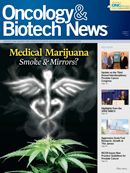Publication
Article
OBTN
Screening High-Risk Women with MRI
Author(s):
As part of our ongoing coast-to-coast oncology coverage, our writers were live in Texas at the 32nd Annual San Antonio Breast Cancer Symposium (SABCS). Our special SABCS wrap-up delivers all the major breast cancer news�including data on MRI screening, bisphosphonates, and aromatase inhibitors�to oncologists unable to attend the event.
Click here to view as PDF.
Oncology & Biotech News
At the 32nd Annual San Antonio Breast Cancer Symposium (SABCS), which was held December 9-13, 2009, oncologists came from around the globe to review and discuss the latest breast cancer research. writers attended the conference and had the opportunity to speak with some of the investigators about their studies.
At the end of 2009, controversy erupted over the value of annual mammography in screening women aged 40 to 59 years for breast cancer after two large studies suggested that the harm from overtreatment or incorrect treatment outweighed the benefits. The US Preventive Services Task Force weighed in, recommending against mammography screening in the 40- to 49- year age bracket and suggesting that women aged 50 to 59 years receive screening every 2 years instead of annually.
Many oncology professionals took issue with the recommendations, maintaining that early screening saves lives and that reducing unnecessary procedures can be accomplished through improving communication between physician and patient to reassure women with low-risk disease that it may be okay to take a watch-and-wait approach.
BRCA1
BRCA2
But what about women in high-risk categories? Ellen Warner, MD, MSc, medical oncologist, Department of Medicine, Division of Medical Oncology, Sunnybrook Health Sciences Center in Toronto, Canada, noted that women with a or mutation “must choose from one of 2 extremely imperfect options…They can have their breasts surgically removed, which drastically cuts their risk of breast cancer but at the cost of significant morbidity. Or, they can have ongoing breast surveillance, in the hope that if cancer develops, it will be found at a stage when it’s still curable.”
Prospective screening studies have consistently shown that augmenting mammography with MRI more than doubles sensitivity with an acceptable drop in specificity. The combination is now considered the standard of care for women with these mutations, Warner said. She and her colleagues hypothesized that it would also reduce mortality because cancers caught in earlier stages are more likely to be curable. “If there is not a significant reduction in mortality,” Warner said, “this is not cost-effective.”
BRCA1
BRCA2
The prospective study followed 1275 women in Canada and the United States who had a defective or mutation. Of these women, 445 had enrolled in an MRI screening trial in Toronto and received MRI with mammography; some also received an initial ultrasonography examination. The remaining 830 women made up the control group and were part of a loosely controlled US study in which women were merely advised to undergo annual mammography. Data were included for women aged 25 to 65 years who had not undergone bilateral mastectomy and had no evidence of metastatic disease. The women were followed for 6 years from study entry or until they received a breast cancer diagnosis or had risk-reducing mastectomy. Warner noted that differences in patient characteristics may have affected outcomes (Table), although the group tried to factor for these differences in their analyses.
Warner said that, as expected, they found a higher incidence of ductal carcinoma in situ (DC IS) and stage I cancers in the MRI cohort, with women in this group twice as likely to develop DC IS than the control group. This difference could not be explained. The cumulative incidence of invasive cancer was identical in both groups, occurring in 9.2% of patients in each group. At 9 mm, the mean size of the invasive tumors in the MRI cohort was half the mean size of invasive tumors in the control group, however. In fact, only 1 woman (3%) in the MRI cohort had a tumor >2 cm compared with 17 women (29%) in the control group, a highly statistically significant finding (P = .002). Node-positive disease was also less common in the MRI group, discovered in only 4 women (13%), compared with 26 (40%) in the control group (P = .009).
BRCA2
BRCA1
Data on overall survival and recurrence rates—the primary endpoints of the study—are not expected for another 5 to 10 years. Warner said the findings to date correlate with a marked difference in the cumulative incidence of stage II to IV breast cancer in the follow-up period, which was much lower in the MRI group than in the control group. Women in the MRI cohort were 6 times as likely to develop DCIS and 3 times as likely to develop stage I invasive cancer, but only one-fourth as likely to develop cancer ≥stage II. This suggests that MRI was not associated with overdiagnosis and instead resulted in earlier diagnosis. Warner said, “Although the numbers were small, there was a trend for more benefit from [MRI] screening for women with mutations than those with mutations.”
The study had limitations; a high proportion of the women had prior breast cancer. Bias may also have favored the MRI cohort, which was tightly controlled. Adherence in the mammographyonly study may have been suboptimal. Despite these drawbacks, Warner believes the benefit of MRI was possibly underestimated. She noted that nearly half the cancers detected in the first round of screening were prevalent cancers and believes they might have been detectable had MRI been performed 1 to 2 years earlier. “Incident cancers are smaller than prevalent cancers and less likely to be node positive,” she explained. In the second round of MRI screening, 22 incident cancers were detected, and only 1 was not DC IS or stage I. Warner also noted that the study began in the late 1990s and MRI techniques have greatly improved, making smaller tumors even easier to detect. Whether MRI surveillance lowers breast cancer mortality and is cost-effective remains to be confirmed, she concluded.
